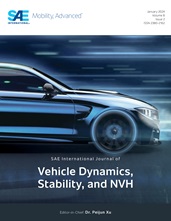Stability Control for a Four-Wheel-Independent-Drive Electric Vehicle Based on Model Predictive Control
- Content
- In four-wheel-independent-drive (4WID) electric vehicles (EVs), the torque of each wheel is independent and controllable. In this study, to address the stability problem of 4WID-EVs in the driving process, the dynamic characteristics of a 4WID-EV are analyzed and a hierarchical stability control strategy is proposed. The upper layer of the proposed control strategy takes the errors of the yaw rate and sideslip angle as inputs and uses a fuzzy control method to calculate the yaw moment of the whole vehicle. The middle layer is the torque distribution optimization control layer. Through model predictive control (MPC), vehicle stability is set to the optimization target, and the motor limit torque is used as the constraint condition. The quadratic programming (QP) method is used to find the optimal torque correction value of each wheel. The lower layer is the execution layer of the motor torque control. Finally, based on Carsim and Simulink software, a joint simulation platform for 4WID-EVs is established to verify the proposed control strategy. The simulation results demonstrate that the proposed control strategy can improve the stability and safety of 4WID-EVs while satisfying the driving dynamic requirements.
- Pages
- 14
- Citation
- Zha, Y., Quan, X., Ma, F., Liu, G. et al., "Stability Control for a Four-Wheel-Independent-Drive Electric Vehicle Based on Model Predictive Control," SAE Int. J. Veh. Dyn., Stab., and NVH 5(2):191-204, 2021, https://doi.org/10.4271/10-05-02-0013.
